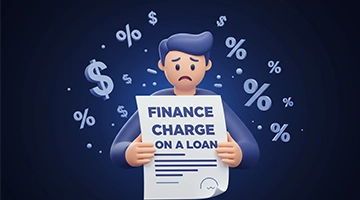What is a Finance Charge on a Loan?

The finance charge is an important factor to assess when choosing a loan. This parameter defines the total cost of borrowing over its life, including interest charges, loan origination fees, maintenance and transaction fees, and penalties, if any.
Knowing how it is represented and determined can help you be more informed and capable of making wiser financial decisions, especially when signing the loan agreement. Let’s take a closer look at how it works.
Table of Contents
- What are Finance Charges?
- Types of Finance Charges
- Examples of Finance Charges
- Importance of Finance Charges
- Know Your Consumer Rights and Regulations
- Tips for Managing Finance Charges
- Conclusion
What are Finance Charges?
A loan finance charge is the total amount of interest and fees you will pay for the life of your loan. This charge depends on the repayment period, APRs, and fees applied to a particular loan. This way, the lending company’s policy and your credit also play an important role. Here are some common components finance charges typically include:
Interest. Interest is the actual price for using the borrowed sum. It is usually expressed in the annual percentage rate, which shows the entire cost of your loan per annum. Loan fees. It includesthe origination cost, the fee charged when processing the loan request, and the closing cost, which is charged when closing the loan deal. Service fees. Your account may involve charges for transfers, transactions, maintenance, and other activities. They are usually applied to credit cards and lines of credit. Late payment fees. These charges are added when the borrower fails to pay or makes it after the due date. Prepayment penalties. Some lenders charge the borrower a fee if the borrower repays the loan before the agreed-upon date. Balance transfer fees. Credit card balances can sometimes be transferred from one credit card to another, but this comes at a cost, normally a percentage of the balance to be transferred. Account management fee. Banks or other financial institutions charge it for taking care of checking accounts.
Types of Finance Charges
Let’s take a closer look at the most common types of finance charges you should consider when borrowing a loan:
Interest Rates
Interest rates usually come in two forms: fixed and variable. Fixed interest rates don’t change for the entire duration of the loan, so your monthly loan payments are also fixed. Variable interest rates can fluctuate over time under certain economic conditions, making your monthly payments unpredictable in the long run.
Interest rates are determined based on a borrower’s credit scores. People with high credit ratings tend to get low rates. Additionally, interest is affected by the type of loan and the central bank’s current economic inflations and policies.
Annual Percentage Rate (APR)
The annual percentage rate, or APR, is even more important to borrowers because it gives a real figure of the total amount of money that one will be charged for borrowing money in a year. That is why APR is a more informative characteristic than the interest rate. Some elements of APR usually involve interest, loan origination fees, closing costs, insurance, and discount points.
Common Additional Fees
Several more charges are usually added to the actual cost of borrowing. Many lenders charge origination fees for processing your loan application. These fees are usually expressed as a percentage of the loan amount and are deducted from your principal.
Additionally, lenders may apply a transaction fee, balance transfer fee, or account maintenance fees. Charges for late payments are also quite common. They are accrued if you make your monthly payment after the due date comes.
Prepayment penalties may also be added to ensure the borrower pays back a loan after a specified term. This helps lenders make more money by charging you more interest over the loan life.
Finally, closing costs are related to loans such as mortgages and entail the charges for items like appraisal fees, title fees, and all the other services necessary to close the loan.
Examples of Finance Charges
To better understand the finance charges, here are several examples depending on the loan type:
Credit Cards
There are several kinds of APRs applied to your credit card. The interest rate that applies to new purchases is the cost, also known as the purchase APR. A cash advance APR is applied to the amount received as cash when you withdraw money from your credit card balance. It’s typically higher compared to what you pay when making a purchase. For example, a credit card might have a 15% purchase APR and a 25% cash advance APR.
A penalty APR is charged if you fail to make timely payments or exceed the credit limit. It is normally higher than the standard, up to 29% or more. Introductory APR is a lower rate for a limited time, usually 6-18 months, which is attractively set at 0% to attract more clients.
Mortgages
Mortgages typically come with APRs of 6% to 8%, origination fees between 0.5% and 1% of the borrowed amount, and closing costs ranging from 2% to 5% of the loan amount. Closing costs include the fees for appraisal, title insurance, and origination. For instance, the $300,000 mortgage home price can range between $6,000 and $15,000 for closing costs.
Personal and Auto Loans
Personal loans usually come with APRs between 5.99% and 35.99%, while auto loans offer lower rates from 3% to 6% due to the collateral backing. Origination fees may be applied for both options. They can range from 1% to 10% of the loan amount. In the case of a $20,000 loan, the origination fee can range between $200 and $2,000. Fees for late payments can also be applied.

Importance of Finance Charges
Finance charges form the cost of your loan, making it crucial to assess their components and know what you can be charged for. Thorough research will help you choose loans that attract lower finance charges and save on their costs. Wonder how to find a finance charge? It’s typically outlined in the loan agreement, so read it attentively before signing.
Know Your Consumer Rights and Regulations
It is crucial to understand consumers’ rights and laws regarding financial wisdom. TILA and the CARD Act are the two laws that safeguard consumers in the financial market. Let’s analyze both acts.
Truth in Lending Act
The Truth in Lending Act is statutory law that requires lenders to disclose all the loan details transparently and uniformly. This implies calculating the finance charges and the annual percentage rate (APR) so consumers can compare various loan offers. These terms must be stated before the loan is processed, which assists consumers in understanding the actual loan cost.
TILA also provides several important protections for consumers, including, but not limited to, the right of a consumer to cancel any type of loan within three days after they signed the document and limits on the consumer’s liability for unauthorized use of a credit card.
Credit Card Accountability Responsibility and Disclosure (CARD) Act
The CARD Act contains consumer protection regarding credit card issuers’ practices. A notable provision is the 21 business days grace period, which requires issuers to post billing statements with the due date at least twenty-one days from the due date. To protect consumers, a grace period allows the client ample time to study the statement and make payments without being charged interest.
Tips for Managing Finance Charges
Here are several simple tips and tricks on managing finance charges from 15M Finance’s financial experts:
- Shop around for loans. It is important to always compare the finance charges offered by different lenders. Every lender has its conditions and rates. By comparing them, you get the best terms and save throughout the loan period.
- Read the fine print. Take time to read all the loan conditions very carefully. This should help eliminate hidden costs, usually written in small fonts.
- Avoid late fees and penalties. Stick to your payment deadlines to avoid any further charges. Use notifications to stay informed and make your payments on time.
- Set up auto payments. Automatic payment allows for electronically withdrawing loan payments from your bank account on a specified date. Use it to avoid missing the required deadline. Additionally, some lenders may offer you interest rate discounts for auto pay.
- Talk to lenders. As with any costs, feel free to ask lenders for better terms and lower fees, especially if you are in good standing. If you have problems with payments, explain the situation and ask for waiving the fee or reducing the price.
Conclusion
Understanding finance charges is crucial for anyone considering taking out a loan. These charges contain interest and various fees that lenders impose, affecting the overall loan cost. By grasping a finance charge, you can make more informed decisions, compare loan offers more effectively, and avoid potential financial pitfalls. Consider how finance charges will impact your repayment amounts and the total cost over time. This awareness can empower you to choose loans that align with your financial goals and capabilities.
See also:
- How Old Do You Have to Be to Take out a Loan? – https://15mfinance.com/blog/how-old-do-you-have-to-be-to-take-out-a-loan/
- Does Paying Off a Loan Early Hurt Your Credit? – https://15mfinance.com/blog/does-paying-off-a-loan-early-hurt-your-credit/
- Why is Your Credit Score Going Down When You Pay On Time? – https://15mfinance.com/blog/why-is-my-credit-score-going-down-when-i-pay-on-time/
References:
- Truth in Lending Act – https://www.occ.treas.gov/topics/consumers-and-communities/consumer-protection/truth-in-lending/index-truth-in-lending.html
- Credit Card Accountability Responsibility and Disclosure (CARD) Act – https://www.ftc.gov/legal-library/browse/statutes/credit-card-accountability-responsibility-disclosure-act-2009-credit-card-act
